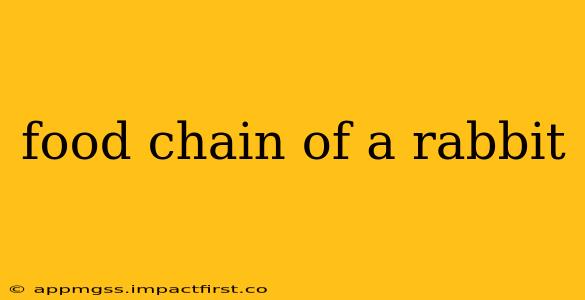Rabbits, with their adorable fluffy appearance, are much more than just cute pets. Understanding their role in the food chain provides a fascinating glimpse into the delicate balance of ecosystems. This comprehensive guide explores the rabbit's position, its interactions with other organisms, and the broader implications for its environment.
What is a food chain and how does a rabbit fit in?
A food chain illustrates the transfer of energy and nutrients within an ecosystem. It begins with producers (plants), which are consumed by primary consumers (herbivores like rabbits), who are then preyed upon by secondary consumers (carnivores). The rabbit, as a primary consumer, occupies a crucial position in many food chains, affecting both plants and predators alike.
What does a rabbit eat? (A Rabbit's Diet)
Rabbits are primarily herbivores, meaning their diet consists mainly of plants. Their specific diet varies depending on their location and the available vegetation. This could include:
- Grasses: A significant portion of a wild rabbit's diet consists of various grasses, providing essential carbohydrates and fiber.
- Forbs: These are broad-leaved herbaceous plants, offering a diverse range of nutrients.
- Twigs and Bark: Rabbits may also consume twigs and bark from shrubs and trees, especially during times of scarcity.
- Fruits and Vegetables: While not a primary food source in the wild, rabbits may consume fruits and vegetables if available. Domesticated rabbits often receive supplemental fruits and vegetables as part of a balanced diet.
What eats a rabbit? (Rabbit Predators)
Rabbits face numerous predators in their natural environment, making them an important part of the food chain for many animals. These predators include:
- Foxes: Highly adept hunters, foxes are significant predators of rabbits, utilizing their cunning and speed to catch their prey.
- Coyotes: Similar to foxes, coyotes are opportunistic predators that include rabbits in their diet.
- Hawks and Owls: Birds of prey are also efficient hunters, targeting rabbits from above.
- Weasels and Ferrets: These smaller predators are agile and can successfully hunt rabbits, especially young or vulnerable individuals.
- Snakes: Certain snake species, particularly larger constrictors, may also prey on rabbits.
- Domestic Cats and Dogs: While not natural predators, feral or unsupervised domestic cats and dogs can pose a significant threat to rabbit populations.
What are some common rabbit parasites and diseases?
While predators are a significant threat, rabbits are also susceptible to various parasites and diseases that can weaken them and make them more vulnerable to predation. These can include internal and external parasites like fleas, ticks, and intestinal worms, as well as various viral and bacterial infections. The health of the rabbit population directly impacts its role in the food chain.
How do rabbits impact their environment? (Rabbit's Ecological Role)
Beyond their position as prey, rabbits play a significant role in shaping their environments. Their grazing habits influence plant communities, helping to maintain biodiversity by preventing overgrowth of certain plant species. Their burrows can also provide shelter for other small animals, further enhancing the complexity of the ecosystem.
How does human activity affect the rabbit food chain?
Human activities, such as habitat destruction, pollution, and hunting, significantly impact rabbit populations and the broader food chain. These disruptions can lead to imbalances, affecting both predator and prey populations. Conservation efforts focusing on habitat preservation and responsible management are crucial for maintaining the delicate balance of these ecosystems.
This detailed exploration of the rabbit's place in the food chain highlights its critical role in various ecosystems. By understanding these complex interactions, we can better appreciate the importance of conservation and the delicate balance of nature.
